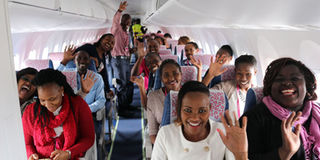Airline regulator changes name

Passengers in a plane. The Amended Act has accorded unrestricted powers to UCAA to inspect aerodromes, air operator premises and aircraft without prior notice. FILE Photo
What you need to know:
The Civil Aviation Authority (CAA) Amendment Act 2019, has christened the aviation regulator to now Uganda Civil Aviation Authority (UCAA) from the mere CAA, Dorothy Nakaweesi writes.
An amended Act has accorded Civil Aviation Authority (CAA) more authority on top of changing its name, making the airline regulator more autonomous.
The CAA Amendment Act 2019 which President Yoweri Museveni assented to, has christened the regulator to now Uganda Civil Aviation Authority (UCAA) from the mere CAA.
UCAA will now be headed by the Director General whose old title was executive director and be deputised by Deputy Director General from deputy managing director.
CAA’s manager public affairs, Mr Vianney Luggya in an interview with Prosper Magazine, said: “The Amended Act has accorded unrestricted powers to UCAA to inspect aerodromes, air operator premises and aircraft without prior notice.”
In the new arrangement, UCAA will now provide on spot penalties to enhance safety and efficiency in service provision in the industry.
Unlike the old Act, UCAA inspectors had to first seek permission from air operators and aerodrome operators to visit their premises for routine inspections.
Mr Luggya said: “The old arrangement often compromised Uganda’s scores in relation to Aviation Legislation in previous International Civil Aviation Organisation (ICAO) audits.”
ICAO is a specialised agency of the United Nations which codifies the principles and techniques of international air navigation. It also fosters the planning and development of international air transport to ensure safe and orderly growth.
Mr Luggya further said some of the changes which take immediate effect were aimed at ensuring harmonisation of Uganda’s regulations and practices with the universal practice across the globe.
Standards
The establishment and maintenance of international Standards and Recommended Practices (SARPs), as well as Procedures for Air Navigation (PANS), are fundamental tenets of the ICAO’s mission and role.
SARPs and PANS are critical to ICAO member states and other stakeholders, given that they provide the fundamental basis for harmonised global aviation safety and efficiency in the air and on the ground, the worldwide standardisation of functional and performance requirements of air navigation facilities and services, and the orderly development of air transport.
Today, ICAO manages over 12,000 SARPs across the 19 Annexes and five PANS to the Convention, many of which are constantly evolving in concert with latest developments and innovations.
Typically, it takes approximately two years for an initial proposal for a new or improved Standard, Recommended Practice or procedure to be formally adopted or approved for inclusion in an Annex or a PANS. Occasionally, this timescale can be expanded or compressed depending on the nature and priority of the proposal under consideration.
ICAO
In her remarks to the conference session on “The 75th Anniversary of ICAO last month: What Future For Civil Aviation”, ICAO’s Secretary General, Dr Fang Liu said: “For many countries, and especially those we refer to in the United Nations as ‘Landlocked and Small Island Developing States’, air transport connectivity serves as a critical economic lifeline.”
“This plays a very important role in supporting countries’ efforts to achieve the 17 Sustainable Develop Goals adopted under the UN’s Agenda 2030,” Liu added.
She stressed that it is a key current priority for ICAO to help governments appreciate the links between their aviation investments, compliance to global standards, and sustainable local economic growth.
new ucaa versus old caa
In the new arrangement, UCAA will now provide on spot penalties to enhance safety and efficiency in service provision in the industry.
Unlike the old Act, UCAA inspectors had to first seek permission from air operators and aerodrome operators to visit their premises for routine inspections.




